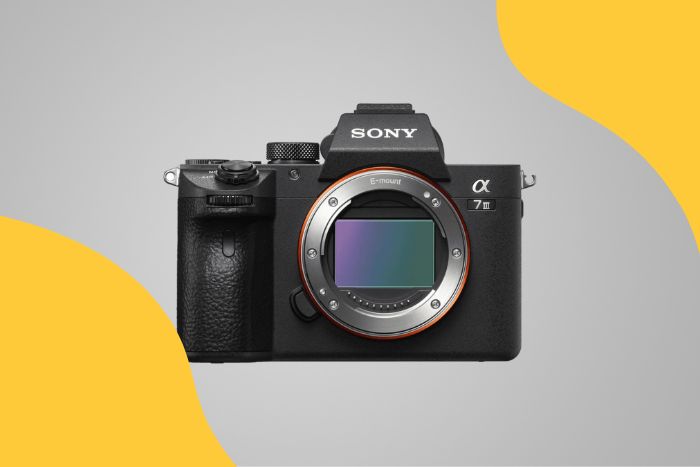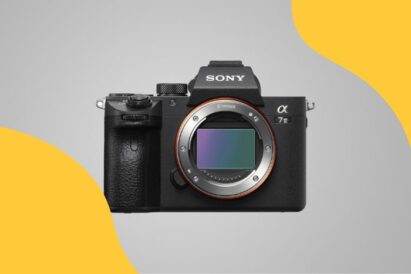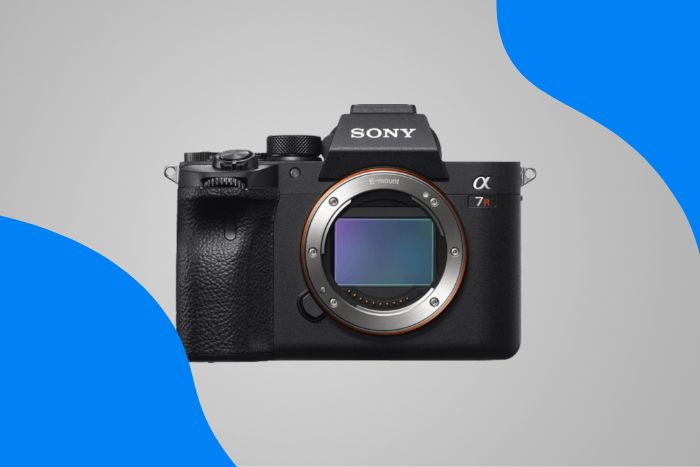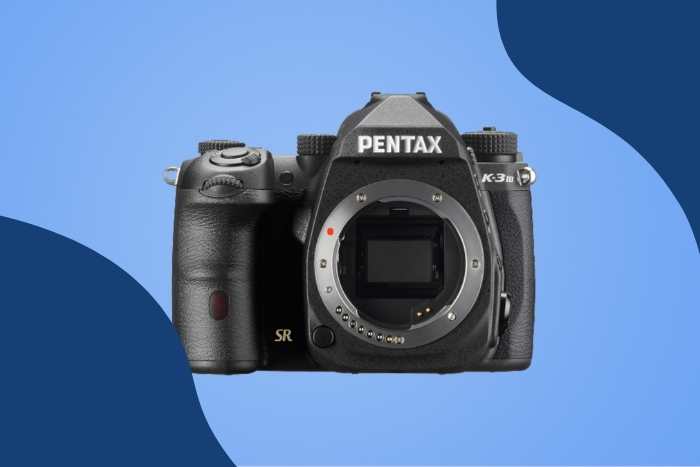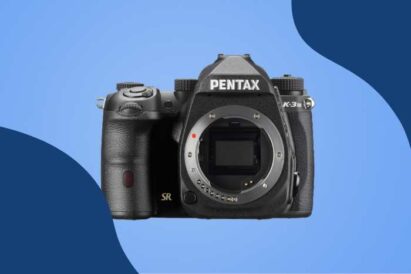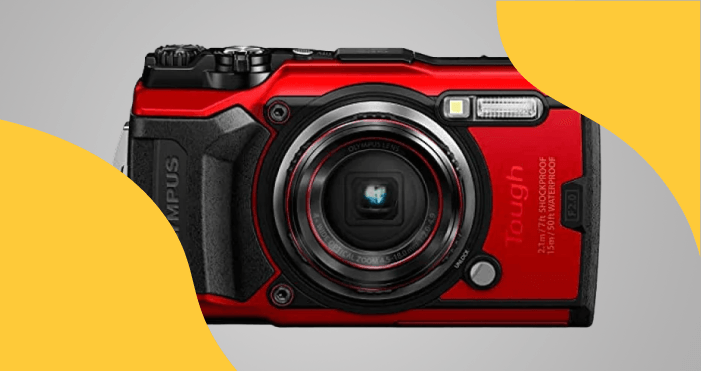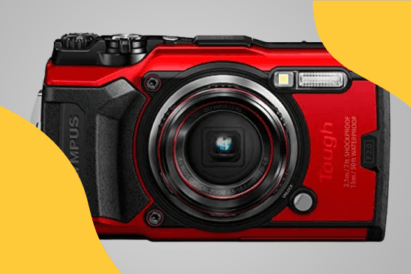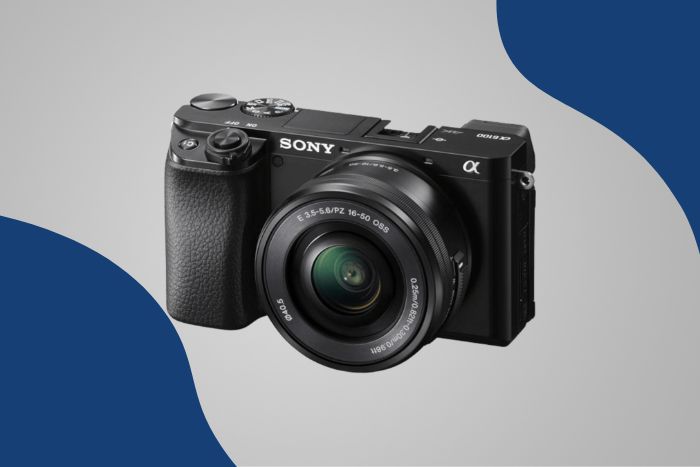Do you want to upgrade from a phone or point-and-shoot camera to a budget DSLR? Your best bet is an APS-C model. These crop-sensor cameras are generally smaller than full frame ones. The native lenses are also smaller, lighter, and less expensive.
You sacrifice resolution. But an APS-C is a great first DSLR camera. It’s a stepping stone to bigger and better things. Almost all the best budget DSLR cameras on our list are APS-C models, such as the Nikon D500. They all have an optical viewfinder.
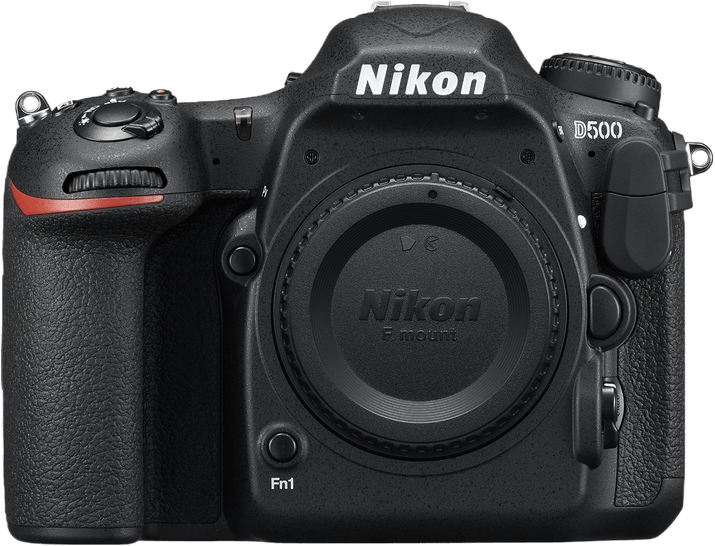
Nikon D500
If you want to jump in with both feet, you can buy a full frame DSLR like the Canon EOS 5D Mark III. But they’re much more expensive—especially once you’ve bought lenses and accessories. A mirrorless camera is also an option for beginners, but this article will focus on DSLRs.
My first camera was a full frame SLR, but that was back in the days of film, and a lot’s changed since then! Fortunately, digital cameras have made the world of photography much more accessible. I’m glad I no longer have to buy film and pay for processing!
What are the Best Budget DSLR Cameras for Beginners?
Let’s take a quick look at the best budget DSLR cameras on the market. These affordable cameras range between $300 and $1700 at the time of writing.

- Excellent low-light performance
- 10 fps RAW burst with 200-image limit
- Weather-sealed body
- Long-lasting battery life
- 4K video with ports for external sound recording
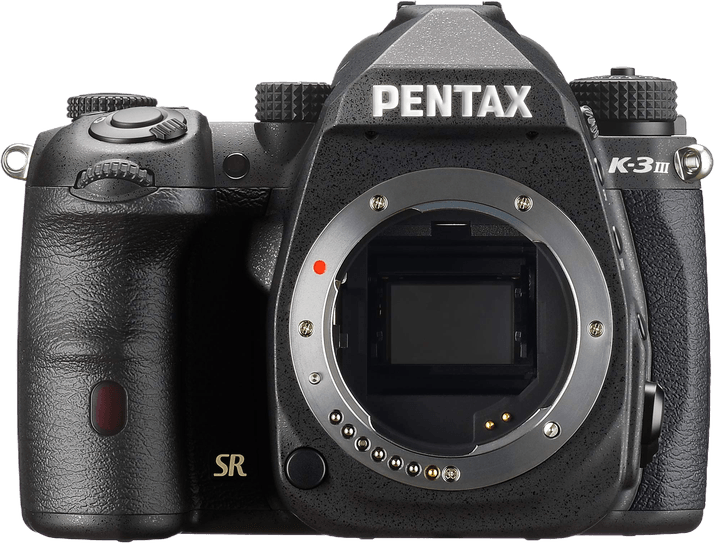
- Pixel Shift high-resolution images
- Accurate and fast autofocus
- 5.5-stop shake reduction
- Astrotracer tracks stars in the sky
- Sharp detail and 4K video

- Great value for money
- Smaller, compact DSLR body
- Easy to handle and hold
- Long battery life

- Excellent 32.5 MP APS-C sensor
- Dual Pixel AF with eye detection
- Decent frame rate of 10 fps
- Good, 1,300-shot battery life
- Live View and 4K/30p Ultra HD video
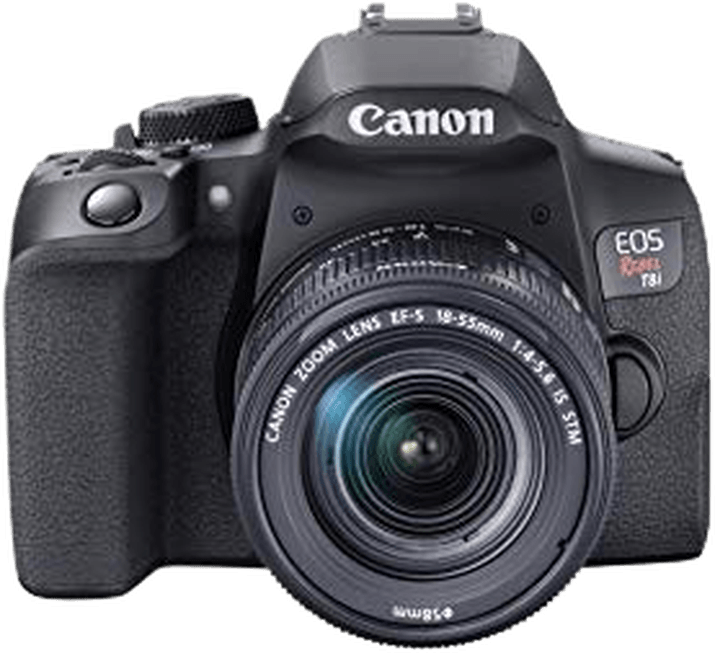
- Excellent image quality
- Face and eye-detection AF
- Great ISO range and low-light performance
- 4K/25p and Full HD/120p video
- Webcam functionality and remote shooting with smartphone
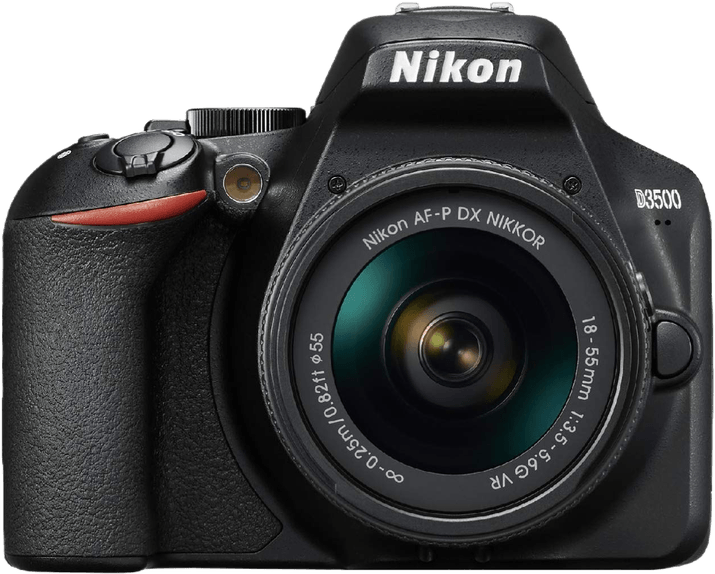
- Excellent image quality
- Guide mode for beginners
- Easy to use and wide functionality
- Long battery life
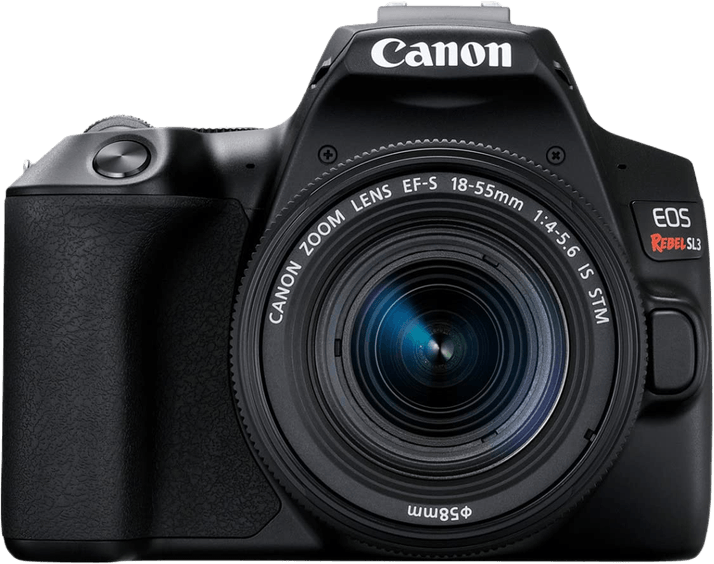
- Excellent value
- Compact body for a DSLR
- Insanely good battery life
- Fully articulating screen is helpful for capturing video
- Solid 4K video quality
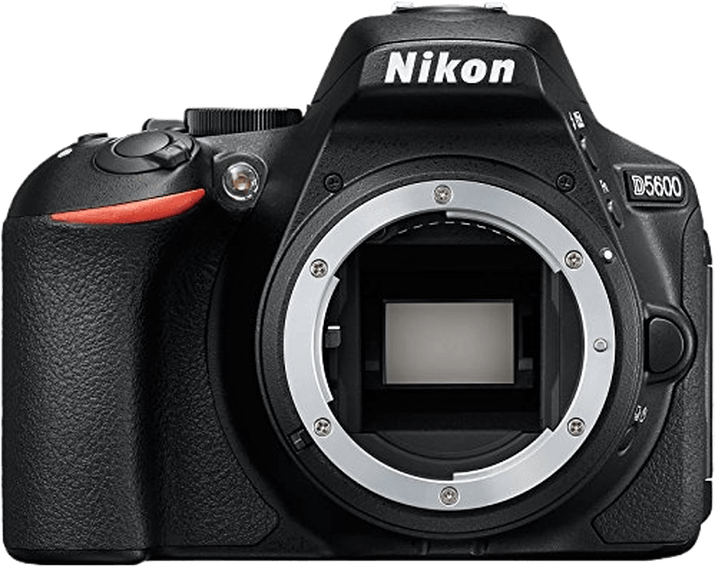
- High quality images for crop sensor
- Great ISO sensitivity
- Fast 39-point AF system
- Not too bulky and nice to handle
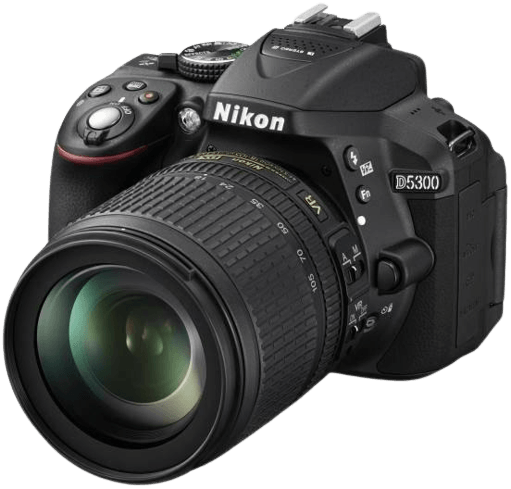
- Superb image quality
- 39-point AF covers frame
- Custom Fn button
- Fully articulated LCD
- Geo-tagging

- Brilliant low-light performance with a wide ISO range
- Excellent image quality and sensor
- Built-in image stabilizer reduces camera shake
- High-quality pentaprism viewfinder
- Durable body with full weather sealing

- Tried and tested, reliable camera
- Strong low-light performance
- Has a high dynamic range
- Dual slots for SD and CF cards
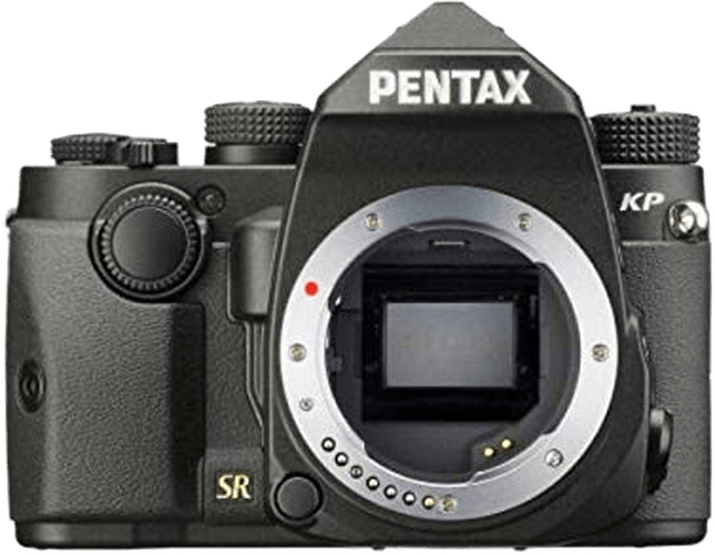
- Fantastic ISO range and low-light performance
- 5-axis in-body image stabilization
- Reactive face-recognition AF tracking
- Robust, weather-sealed body

- Fast, accurate, 45-point Dual Pixel AF
- 5-axis image stabilization to help reduce camera shake
- Excellent Live View performance
- Good ergonomics and handling
- Easy Wi-Fi and Bluetooth connections
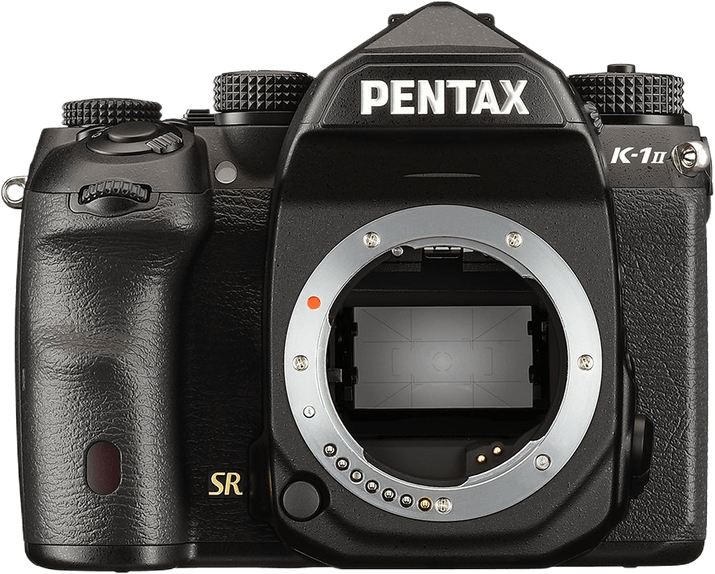
- Plenty of manual controls
- A wide ISO range for low light
- 5-axis Shake Reduction II worth 2.3 to 3.6 shutter stops
- Dynamic Pixel Shift resolution provides sharper images
- Astrotracer tracks stars at night
- Durable camera body with excellent weather sealing
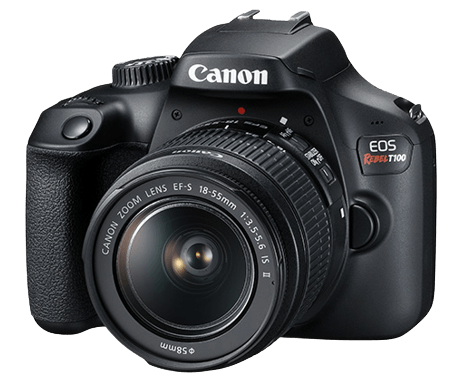
- Affordable
- Tracking AF system
- Beginner-friendly controls
- Lightweight and ergonomic body
- Wide range of compatible lenses
15 Best Budget DSLR Cameras in Detail
It’s time to dive in and look at all your options in more detail. These are beginner DSLRs with options for interchangeable lenses. They have some flaws. But they are perfect for photographers just starting.
1. Nikon D500

| Camera Type |
Camera Type
|
| Megapixels |
Megapixels
20.9 MP |
| Sensor Format |
Sensor Format
|
| Sensor Size |
Sensor Size
15.7 x 23.5 mm
|
| Frame Rate |
Frame Rate
10 fps |
| Autofocus Points |
Autofocus Points
153 |
- Excellent low-light performance
- 10 fps RAW burst with 200-image limit
- Weather-sealed body
- Long-lasting battery life
- 4K video with ports for external sound recording
- Low resolution for an APS-C Sensor
- No advanced bird or animal AF
- Slow AF in Live View
- Heavy DSLR body
- 4K video is cropped
The Nikon D500 is a higher-priced but durable DX-format (APS-C) DSLR camera. It offers superb autofocus (AF) and stunning images in RAW and JPEG format. It has a wide dynamic range and features great performance at high ISOs.
You also get comfortable and convenient ergonomics, long battery life, a deep buffer, and a fast frame rate (for a DSLR!). That’s helped by support for fast XQD and CFexpress memory cards. All this makes it ideal for those who want to start in sports and wildlife photography.
The autofocus comes from the professional-grade Nikon D5 and has an AF Fine Tune option. There’s a 180,000-pixel metering RGB sensor for subject recognition and metering.
There are 153 autofocus points with 99 cross-type sensors. They offer subject tracking across most of the frame. You can select one of the 55 selectable focus points using the tilting touch screen or an AF joystick on the rear.
You can even temporarily engage a different one. You can also specify the type of movement and the “stickiness” of the focus lock in the menus.
The camera has several user-friendly features:
- Dust and water resistance
- Customizable buttons
- Several connections for quick and easy uploads (Wi-Fi, NFC, Bluetooth, and USB 3.0)
The viewfinder offers 100% coverage and 1.0x magnification for accurate framing. There’s even an anti-flicker mode for indoor shooting in fluorescent light. But it’s a bit heavy, and the SnapBridge app for transferring 2 MP photos to your mobile is unreliable.
The D500 does offer excellent 4K video. But there’s a 1.5x crop (2.25x relative to full frame). And there are few tools besides exposure highlight warnings and power aperture control. The autofocus, when recording, also tends to wobble and “hunt. But you do get microphone and headphone ports.
2. Pentax K-3 Mark III

| Camera Type |
Camera Type
|
| Megapixels |
Megapixels
26 MP |
| Sensor Format |
Sensor Format
|
| Sensor Size |
Sensor Size
23 x 15.5 mm
|
| Frame Rate |
Frame Rate
12 fps |
| Autofocus Points |
Autofocus Points
101 |
- Pixel Shift high-resolution images
- Accurate and fast autofocus
- 5.5-stop shake reduction
- Astrotracer tracks stars in the sky
- Sharp detail and 4K video
- Expensive for an APS-C DSLR
- Only 25 shots in buffer
- Only accepts slower SD cards
- Fixed LCD and joystick can't be used in menu system
- Heavy 4K crop, only 8-bit video
The Pentax K-3 Mark III is another “pricier” budget APS-C DSLR on our list. The new sensor provides detailed images with built-in noise reduction and good detail. They might even be better than what you get with the Nikon D500. The sensor allows the following:
- Pixel Shift high-resolution resolution images
- Astrotracer for easy star photography
- An anti-aliasing simulator to help prevent false color and moiré
It has a precise and fast SAFOX 13 autofocus, a fast continuous shooting speed, and a 5.5-stop shake reduction. The autofocus is controlled using the joystick. And it works up to 11 frames per second (fps). But the buffer is only 25 shots.
It doesn’t help that you can only use slower SD cards. And only one slot supports UHS-II cards. The autofocus is generally not quite as good as on the Nikon D500. But it’s an improvement on previous Pentax models.
The body is well-built, with a 1.05x magnification viewfinder and a comfortable thumb rest. It has twin control dials. And there’s a customizable e-dial that works with the Smart Function button. These controls appear in the viewfinder. There are five user modes and a lot of customizable controls—all nicely positioned.
The K-3 Mark III is the first Pentax camera to offer high-quality 4K Ultra HD video. It’s easy to change settings in the menu system. And there are microphone and headphone ports. The main video drawbacks? The lack of continuous autofocus and the 1.4x crop (or 2.1x in the full frame equivalent). This has an impact on low-light performance.
It’s also only 8-bit rather than 10-bit output. This means less detail and tonality. And it doesn’t offer 4K / 60p to slow down footage in post-production.
You also get a touch screen. But it’s fixed, and you can’t use the joystick to scroll between menu options. Battery life is average. But at least you can charge the camera using a cable connected to the USB port.
3. Nikon D7500

| Camera Type |
Camera Type
|
| Megapixels |
Megapixels
20.9 MP |
| Sensor Format |
Sensor Format
|
| Sensor Size |
Sensor Size
15.7 x 23.5 mm
|
| Frame Rate |
Frame Rate
8 fps |
| Autofocus Points |
Autofocus Points
51 |
- Great value for money
- Smaller, compact DSLR body
- Easy to handle and hold
- Long battery life
- Images not as sharp as other cameras
- Limited to crop sensor (DX) lenses
- No USB charging
- Just one memory card slot
The Nikon D7500 is a mid-range APS-C DSLR camera. It replaces the D7200. And it uses the sensor, processor, and 180,000-pixel metering sensor from the D500. It can perform highlight-weighted metering and has an enormous ISO range. It also has a tilting touch screen and weather-sealing in a lighter body than the D7200.
RAW and JPEG quality is high (despite the slightly low resolution). You also get auto fine-tuning, a fast frame rate, a deep buffer, and 51-point autofocus. This provides subject recognition and “sticky” 3D tracking. All this makes it a great camera for action photography. But there’s no touchpad AF.
It helps that there are twin control dials. They make it much quicker to change your settings on the fly. But there is no integrated grip for easier vertical shots or extended battery life. And you can’t even buy one as an accessory.
It’s capable of 4K video. But video quality suffers from the 1.5x crop (or 2.25x full frame equivalent) and lack of focus peaking for low light. The slow, contrast-detect autofocus also tends to wobble and “hunt.”
4. Canon EOS 90D

| Camera Type |
Camera Type
|
| Megapixels |
Megapixels
33 MP |
| Sensor Format |
Sensor Format
|
| Sensor Size |
Sensor Size
22.3 x 14.9 mm
|
| Frame Rate |
Frame Rate
10 fps |
| Autofocus Points |
Autofocus Points
45 |
- Excellent 32.5 MP APS-C sensor
- Dual Pixel AF with eye detection
- Decent frame rate of 10 fps
- Good, 1,300-shot battery life
- Live View and 4K/30p Ultra HD video
- Unreliable autofocus when using the optical viewfinder
- 4K video has a soft focus
- No in-body image stabilization
- Limited video codecs and frame rates
The Canon EOS 90D is a mid-range APS-C DSLR camera. It features the highest-resolution crop sensor on the market… plus a few other bells and whistles.
It works best in Live View, with the DIGIC 8 processor and updated 220K-pixel metering sensor. They feature face and eye detection. Canon’s Dual Pixel AF provides fast and accurate focus and subject tracking. That’s for both stills and video.
The frame rate is high enough for a DSLR. And the fully articulating touch screen and AF joystick are handy. You also get some of Canon’s “standard features.” These include weather-sealing, Wi-Fi, Bluetooth, headphone, microphone, and USB 2.0 ports.
The 90D replaces the 80D. The body is just as well-built. It has comfortable ergonomics and a viewfinder offering 100% coverage. RAW file quality is outstanding, with great sharpness and noise performance. Canon’s JPEG colors are always popular. But the default noise reduction is too much. It needs to be reduced.
You can shoot some really nice 4K video with no crop. But there is no 24p for standard video resolution. And there are no Log gamma options for advanced editing. So the footage is soft. There’s also no in-body image stabilization (IBIS) to help with handheld shooting. Instead, you need to use digital image stabilization. Plus, the video comes with a heavy crop.
5. Canon EOS Rebel T8i

| Camera Type |
Camera Type
|
| Megapixels |
Megapixels
24 MP |
| Sensor Format |
Sensor Format
|
| Sensor Size |
Sensor Size
14.9 x 22.3 mm
|
| Frame Rate |
Frame Rate
7.5 fps |
| Autofocus Points |
Autofocus Points
45 |
- Excellent image quality
- Face and eye-detection AF
- Great ISO range and low-light performance
- 4K/25p and Full HD/120p video
- Webcam functionality and remote shooting with smartphone
- Fiddly control dials
- Less reliable AF in video mode
- Small optical viewfinder display
- Cropped 4K video
The popular Canon Rebel T8i replaces the T7i. In some countries, it’s called the Canon EOS 850D (Europe) or Canon EOS Kiss X10i (Asia). It’s the company’s flagship APS-C DSLR camera. And it’s compatible with the EF and EF-S ranges of lenses. It has an optical viewfinder. But you can also use it almost as a mirrorless camera by using the touch screen.
It looks like the T7i, except for the new rear control dial and the AF-ON button. You get a slightly faster frame rate and an improved 384-zone metering sensor.
The autofocus system now offers face detection when shooting through the viewfinder. And there is eye detection in Live View. But the pentamirror design is limited. This means the viewfinder only manages 95% coverage with 0.51x magnification.
The T8i can shoot video in 4K. But the frame rate is fixed, and there’s a heavy, 1.6x crop. The autofocus also uses less contrast detection rather than Dual Pixel AF.
6. Nikon D3500

| Camera Type |
Camera Type
|
| Megapixels |
Megapixels
24 MP |
| Sensor Format |
Sensor Format
|
| Sensor Size |
Sensor Size
15.6 x 23.5 mm
|
| Frame Rate |
Frame Rate
5 fps |
| Autofocus Points |
Autofocus Points
11 |
- Excellent image quality
- Guide mode for beginners
- Easy to use and wide functionality
- Long battery life
- No touchscreen
- No 4K video
- No Wi-Fi, only Bluetooth
- Screen does not rotate
The Nikon D3500 is a DX-format (or APS-C) DSLR camera. It has a great Guide mode for beginners. It’s cheaper and lighter than the D3400 it replaced and offers better battery life.
Guide mode lets you tell the camera what kind of shot you want to take and then talks you through how to do it. That includes the basics of photography, including shutter speed, aperture, and exposure compensation.
You can choose Easy Operation if you want the camera to select the settings for “moving subjects,” say. Otherwise, Advanced Operation gives you more control.
The sensor is one of the best APS-C sensors on the market, leading to excellent performance at low ISOs. The limited ISO range, 11-point focus system, and slow burst rate are also acceptable at this level.
If you’re upgrading from a smartphone, the Nikon D3500 offers a higher resolution. But it isn’t as easy to use without a touch screen. Plus, it’s also not a great camera for videographers. The highest quality is only Full HD video recording.
But exposure metering is inconsistent. And the autofocus struggles in low light or with moving subjects. Face detection only works in Live View, and Bluetooth file transfer is slow.
Note that Nikon will stop making the D3500 as soon as European stocks have run out. Once that happens, it’ll only be available on the second-hand market.
7. Canon EOS Rebel SL3

| Camera Type |
Camera Type
|
| Megapixels |
Megapixels
24 MP |
| Sensor Format |
Sensor Format
|
| Sensor Size |
Sensor Size
22.3 x 14.9 mm
|
| Frame Rate |
Frame Rate
5 fps |
| Autofocus Points |
Autofocus Points
9 |
- Excellent value
- Compact body for a DSLR
- Insanely good battery life
- Fully articulating screen is helpful for capturing video
- Solid 4K video quality
- Only 9 autofocus points
- Lacks in-body image stabilization
- No USB charging
- No weather sealing
- 1.7x 4K crop factor
The Canon EOS Rebel SL3 is also known as the EOS 250D or 200D Mark II in certain countries. It’s an APS-C DSLR camera that improves on the old SL2. Canon added 4K video and Eye AF in Live View in a smaller, lighter body.
Like the D3500, it has a Guided UI (user interface). It helps you learn photography skills while you shoot. It also has a Creative Assist mode for experimenting with other special effects. But you can always switch to manual mode whenever you feel ready.
The Canon Rebel SL3 combines Canon’s best APS-C sensor with the DIGIC 8 image processor. This improves the signal-to-noise ratio. And it leads to sharper images and a higher dynamic range, particularly at high ISOs.
But you must enter Live View to take advantage of the Dual Pixel AF system. It’s based on phase detection. And this makes it quicker than the contrast detection systems on many cameras.
The Canon Rebel SL3 has 3,975 selectable focus points. They cover 88% of the width and 100% of the height of the frame. You can choose between several focus options in either single-shot mode or Servo AF mode:
- Single-point AF
- Spot AF (an even smaller point)
- Zone AF
- Subject-tracking AF
The vari-angle touch screen, Wi-Fi (with NFC), and Bluetooth connectivity are useful. But the frame rate is average. And the autofocus only works with nine focus points through the viewfinder.
You can shoot 4K video on the Canon Rebel SL3. But the crop factor is high, the focus is a little slow, and you can’t use Spot AF or Zone AF. The optical low-pass filter also reduces the resolution slightly. But subject tracking is excellent!
8. Nikon D5600

| Camera Type |
Camera Type
|
| Megapixels |
Megapixels
24.2 MP |
| Sensor Format |
Sensor Format
|
| Sensor Size |
Sensor Size
15.6 x 23.5 mm
|
| Frame Rate |
Frame Rate
5 fps |
| Autofocus Points |
Autofocus Points
39 |
- High quality images for crop sensor
- Great ISO sensitivity
- Fast 39-point AF system
- Not too bulky and nice to handle
- Autofocus isn't great in video mode
- No dual memory card slots
- No USB charging
- No Nikon Fine-Tune function to adjust AF for specific lenses
The Nikon D5600 is a mid-range DX-format (APS-C) DSLR camera like the D5300. D5x00 models sit between Nikon’s D3x00 and D7x00 series. It’s in the middle of the pack for ease of use, performance, and customization options.
Sharpness is generally a little better than on other competing APS-C cameras. This is due to the lack of an optical low-pass filter—though at the expense of increased noise. The autofocus with touchpad AF is fast, accurate, and tracks moving subjects well.
There’s also a touch screen and built-in Wi-Fi, NFC, and Bluetooth connections. But you only get HD video (with poor autofocus and no aperture control while recording). The frame rate and buffer are also unimpressive—as on so many Nikon DSLRs!
The only real change from the earlier D5500 is the addition of SnapBridge. This is the Bluetooth-enabled app for automatically transferring 2MP images to a smartphone. It sounds like a good idea, but reviews have been mixed! It tends to be unreliable and works differently on Android and Apple devices:
On Android phones, you pair the camera and phone using NFC. Then you press the “i” button in playback mode to transfer an image. But Apple doesn’t permit NFC connections, so the pairing process takes longer.
SnapBridge offers remote Live view, remote camera operation, and video transfer using Wi-Fi. But it’s fairly basic, time-consuming, and unreliable. It doesn’t compare well with Apple’s iCloud if you have an iPhone!
The viewfinder is also a weakness. It uses a pentamirror rather than the standard pentaprism to reduce size and weight. That means it can only show 95% of the frame. So it isn’t large or bright enough for accurate framing—especially in low light.
Continuing on the same theme of handling and usability, you can only toggle Auto ISO on and off in the menu system. And there’s also only one control dial. This makes it much slower to change settings. Other models have two dedicated dials for shutter speed and aperture.
Touchpad AF is also a problem. It’s a nice feature, but it doesn’t work if you like putting your left eye on the viewfinder!
9. Nikon D5300

| Camera Type |
Camera Type
|
| Megapixels |
Megapixels
24.2 MP |
| Sensor Format |
Sensor Format
|
| Sensor Size |
Sensor Size
15.6 x 23.5 mm
|
| Frame Rate |
Frame Rate
5 fps |
| Autofocus Points |
Autofocus Points
39 |
- Superb image quality
- 39-point AF covers frame
- Custom Fn button
- Fully articulated LCD
- Geo-tagging
- Laggy live view
- No live view preview of aperture changes
- Slow live view autofocus
- No 4K video
- Info screen hard to read
The Nikon D5300 is another DX-format (APS-C) DSLR camera—although a couple of years older than the D5600. It improves on its predecessor, the D5200. Nikon removed the optical low-pass filter to achieve better sharpness. But this was at the expense of more noise.
You now get 60p HD video and a slightly larger, higher-resolution LCD. It also has a 20% longer battery life. The autofocus has 39 focus points (nine cross-type). And the D5300 is the first Nikon DSLR with built-in Wi-Fi and GPS features.
Video quality is “only” HD rather than 4K. But there’s no crop. You capture motion smoothly and can output RAW video using an HDMI cable and plug in an external mic.
The only real issues are the slow autofocus in Live View and the handling. It would be nice to see a second function button, twin front and rear command dials, and a touch screen. But I guess we can’t expect the world from an entry-level camera!
10. Pentax K-70

| Camera Type |
Camera Type
|
| Megapixels |
Megapixels
24 MP |
| Sensor Format |
Sensor Format
|
| Sensor Size |
Sensor Size
23.5 x 15.6 mm
|
| Frame Rate |
Frame Rate
6 fps |
| Autofocus Points |
Autofocus Points
11 |
- Brilliant low-light performance with a wide ISO range
- Excellent image quality and sensor
- Built-in image stabilizer reduces camera shake
- High-quality pentaprism viewfinder
- Durable body with full weather sealing
- Limited AF system for fast-moving subjects
- Slow buffering when shooting in RAW
- Slow max burst speed of 6 fps
- Poor connecting Wi-Fi app
- Only Full HD video, no 4K recording
The Pentax K-70 is a customizable mid-level DSLR. It offers excellent, low-noise RAW image quality for an APS-C camera and plenty of features. You get a decent frame rate and weather-sealing.
It features the Pentax Shake Reduction system and Pixel Shift Resolution. They move the sensor one pixel in every direction. This results in better color detail and lower noise.
And the K-70 achieves better sharpness by having no optical low-pass filter. But it does offer a filter simulator to reduce moiré. The SAFOX X on-sensor phase-detect autofocus has only 11 focus points (nine cross-type). So you may have to focus and recompose to keep static subjects sharp.
Autofocus only works down to -3 EV. Plus, subject tracking is limited, and continuous autofocus struggles with video. But you can at least fine-tune the autofocus for any camera and lens combination.
The video is limited to HD, and the footage is soft. But you can use continuous AF. The autofocus has a habit of “hunting,” so Single AF is often better.
With usability, it’s well-built but a bit heavy. It offers the rare benefit of customizable twin control dials. And it has a large viewfinder with full coverage.
It also has a user-friendly Wi-Fi connection. On the downside:
- There’s no touch screen.
- The battery life is short.
- Shake Reduction only works on the sensor, not the viewfinder
Finally, you need the right lens to take advantage of all the K-70 features. The Pentax DA-55-300mm lens does this admirably. But it’s not available as a kit lens.
11. Canon EOS 5D Mark III

| Camera Type |
Camera Type
|
| Megapixels |
Megapixels
22.3 MP |
| Sensor Format |
Sensor Format
|
| Sensor Size |
Sensor Size
24 x 36 mm
|
| Frame Rate |
Frame Rate
6 fps |
| Autofocus Points |
Autofocus Points
61 |
- Tried and tested, reliable camera
- Strong low-light performance
- Has a high dynamic range
- Dual slots for SD and CF cards
- Some disappointing JPEG rendering
- AF in Live View is clunky
- Fixed screen is not touch sensitive
- Video recording is time limited
The Canon 5D Mark III is a popular, customizable full frame DSLR camera. It offers better image quality and improvements in almost every respect over the Mark II. But the specs are still “average” rather than “outstanding.”
The specs don’t match those of the 36 MP D800, released around the same time. You get no 4K video, a frame rate slower than the D7500, and mushy JPEGs. Plus, there are fewer megapixels than an APS-C camera!
On the plus side? The new sensor and DIGIC 5+ processor offer a wide ISO range. And they also correct chromatic aberration with JPEGs (for Canon lenses). It has a 61-point focus system and accompanying menu options. This comes from the top 1DX range of cameras.
The viewfinder covers 100% of the frame, and the Q-menu gives you rapid access to common settings. The body is weather-sealed, battery life is good, and there’s a silent shutter mode.
You can also create HDR and multiple exposure images in-camera. The bracketing range now includes seven frames covering +/- 8 EVs. In another nice touch, you can even compare images side-by-side in playback mode.
The lack of 4K video and a mono microphone is disappointing. But you get some benefits:
- Live View and movie mode switch
- Headphone and microphone ports
- Better All-I and more flexible IPB video compression
Touch-sensitive buttons let you silently change exposure, ISO, and volume while recording. But you can’t output uncompressed footage over HDMI as you can on Nikon’s DSLRs.
12. Pentax KP

| Camera Type |
Camera Type
|
| Megapixels |
Megapixels
24 MP |
| Sensor Format |
Sensor Format
|
| Sensor Size |
Sensor Size
23.5 x 15.6 mm
|
| Frame Rate |
Frame Rate
7 fps |
| Autofocus Points |
Autofocus Points
27 |
- Fantastic ISO range and low-light performance
- 5-axis in-body image stabilization
- Reactive face-recognition AF tracking
- Robust, weather-sealed body
- No 4K video
- No touchscreen
- Unreliable mobile app
- Disappointing battery life
The Pentax KP is a small but rather heavy mid-range APS-C DSLR. It offers good image quality in RAW with a wide ISO range. It has customizable and user-friendly controls and many special features. But continuous AF performance is a letdown.
The body and controls are based on the full frame Pentax K-1. That means full weather-sealing, an interchangeable front grip, and a built-in flash. You also get Shake Reduction II, which permits the Pixel Shift Resolution feature.
The SAFOX 11 autofocus system uses an 86,000-pixel RGB metering sensor. This is for subject tracking and exposure.
It has 27 focus points (with 25 cross-type). You can select them manually using the direction pad. But it’s a little clumsy. You must press and hold it first. Single AF is fine. But continuous AF is unreliable when tracking moving subjects.
The maximum electronic shutter speed and frame rate are decent. And you get built-in Wi-Fi. But the default JPEGs are mushy, the GPS is an optional extra, and battery life is short.
The Function dial is a customizable tool. So you can quickly change settings without taking your eye away from the viewfinder.
But you can only shoot HD footage rather than 4K, and the output is fairly soft. The lack of on-sensor phase-detect autofocus also means it doesn’t work as well as it should.
13. Canon EOS 77D

| Camera Type |
Camera Type
|
| Megapixels |
Megapixels
24.2 MP |
| Sensor Format |
Sensor Format
|
| Sensor Size |
Sensor Size
14.9 x 22.3 mm
|
| Frame Rate |
Frame Rate
6 fps |
| Autofocus Points |
Autofocus Points
45 |
- Fast, accurate, 45-point Dual Pixel AF
- 5-axis image stabilization to help reduce camera shake
- Excellent Live View performance
- Good ergonomics and handling
- Easy Wi-Fi and Bluetooth connections
- Unreliable intelligent AF subject tracking and recognition
- A slow burst rate
- A small viewfinder
- Plasticky build, no weather-sealing
- No 4K video option
Canon sells the EOS 77D as the Canon 9000D in Japan. It’s a mid-size APS-C DSLR based on the EOS 80D. It offers a mixture of benefits from DSLRs and mirrorless cameras:
- Good ergonomics
- Excellent Live View performance
- Rapid and precise Dual Pixel AF
- Easy Wi-Fi and Bluetooth connection
The handling is good. It has dual control dials and a fully articulating touch screen. There’s also an LCD on the top plate to check your settings. It also has an AF-ON button for those photographers who use back-button focus. But there aren’t many options for button customization.
It has an updated 45-point autofocus system—all accurate cross-type points. The new DIGIC 7 processor improves Live View autofocus tracking. But you can only change one setting. The iTR AF subject tracking is unreliable. And there’s no autofocus micro-adjustment. Plus, the burst rate is a little slow for action photography.
You can’t shoot in 4K, and the footage lacks detail. You don’t get a headphone socket or zebra highlights to show overexposure. But the five-axis image stabilization works well when recording handheld. The autofocus is easy to use and reliable with excellent face detection.
You also get scene modes and creative filters such as Toy Camera” and Miniature Effect. There’s a microphone port and a built-in interval timer for time-lapse photography. And the smartphone app also permits remote control and image transfer.
But the viewfinder is small due to the pentamirror design. It also looks plasticky and has no weather-sealing.
14. Pentax K-1 Mark II

| Camera Type |
Camera Type
|
| Megapixels |
Megapixels
36 MP |
| Sensor Format |
Sensor Format
|
| Sensor Size |
Sensor Size
35.9 x 24 mm
|
| Frame Rate |
Frame Rate
4.4 fps |
| Autofocus Points |
Autofocus Points
33 |
- Plenty of manual controls
- A wide ISO range for low light
- 5-axis Shake Reduction II worth 2.3 to 3.6 shutter stops
- Dynamic Pixel Shift resolution provides sharper images
- Astrotracer tracks stars at night
- Durable camera body with excellent weather sealing
- AF is not as refined as others
- A slow frame rate
- Noise reduction always applied leads to soft images
- Limited modern lens selection
- Soft Full HD and no 4K capture
- A short battery life
The Pentax K-1 Mark II is a durable, mid-sized, full frame DSLR. It improves on the original K-1. Pentax introduced a better AF Tracking algorithm and a preprocessor. This increases the ISO limit by 300% and improves noise performance at high ISOs.
It uses full-time noise reduction. But this comes at the expense of softer images, a slow frame rate, and shorter battery life. Video and autofocus performance are also disappointing.
The unique selling point of Pentax cameras is its five-axis Shake Reduction II system. And this one offers 2.3 to 3.6 stops of image stabilization. It also brings other features:
- Dynamic Pixel Shift Resolution that combines images for better color and sharpness
- Horizon correction for landscape photography
- Astrotracer for star photography
High-quality images are also possible at low ISOs with a wide dynamic range. But the built-in noise reduction washes out detail at higher ISOs. And you can’t switch it off. The noise reduction smears detail with JPEGs unless you use Pixel Shift mode.
It uses the SAFOX 12 autofocus system with 33 focus points—although they’re hard to see in the dark. AF tracking is better than on the original K-1 but still unreliable.
Handling is good due to a flexible tilt LCD, built-in GPS, and a Smart Function dial. You get a dedicated outdoor viewing button and Operation Assist Lights to help you shoot in the dark. It’s also weather-sealed and has headphone and microphone jacks, a PC sync port, and dual card slots. But it’s quite bulky and heavy.
Video is limited to HD, and there’s no focus peaking or phase-detect autofocus.
15. Canon EOS Rebel T100

| Camera Type |
Camera Type
|
| Megapixels |
Megapixels
18 MP |
| Sensor Format |
Sensor Format
|
| Sensor Size |
Sensor Size
14.9 x 22.3 mm
|
| Frame Rate |
Frame Rate
3 fps |
| Autofocus Points |
Autofocus Points
9 |
- Affordable
- Tracking AF system
- Beginner-friendly controls
- Lightweight and ergonomic body
- Wide range of compatible lenses
- Limited AF frame coverage
- Live View lags in low light
- Slow 3 fps burst speed
- Cheap plastic body
- Not weather sealed
Canon sells the EOS Rebel T100 as the Canon EOS 4000D or Canon EOS 3000D in certain countries. It’s a no-frills, budget-friendly APS-C DSLR. It offers good image quality. And it has several creative filters such as Vivid, Soft, Cool, and Monochrome.
There are also many scene modes, such as Food and Scene Intelligent Auto. But it has a poor burst rate, a slow, nine-point autofocus system, a poor kit lens, and no 4K video. It also has a small, low-resolution LCD with no touch screen functionality.
It does have a Wi-Fi connection for remote control with touch autofocus. You can also browse and share images using the rather clunky Camera Connect app. And it is very cheap if you don’t want to spend much!
Our Verdict
Do you prefer the DSLR’s form factor (arrangement of features) to a mirrorless camera? If so, the best budget DSLR is probably an APS-C model like the Nikon D500.
APS-C systems are smaller, lighter, and less expensive than their full frame equivalents. But you still get good image quality, fast frame rates, and quick and accurate AF systems.

Nikon D500
Do you prefer a full frame model? The Canon EOS 5D Mark III is probably best if you can find a bundle including the camera body and a kit lens. The big advantage is that you won’t have to buy APS-C lenses that won’t work so well if you upgrade to a full frame camera, but it will cost more…
Common FAQs
Here are our answers to the most often asked questions about the best budget DSLRs for beginners.

What is Canon’s cheapest DSLR?
The cheapest Canon DSLR is the Canon EOS Rebel T100, which has an APS-C sensor. If you want the cheapest full frame DSLR, you’ll have to spend around $1,000 more to get the Canon EOS 6D Mark II.
Which DSLR is best for normal use?
The Nikon D500 is the best all-around DSLR for beginners if you can afford it. It ticks all the boxes. It has the D5’s features… pro-grade autofocus, excellent image quality, fast continuous shooting, and a deep buffer. That makes it ideal for beginners who want to explore sports and wildlife photography.
Is Nikon D3500 good for beginners?
The Nikon D3500 is a DX-format (or APS-C) DSLR camera. It has a Guide Mode to help beginners learn photography while they shoot. And the sensor provides excellent image quality at low ISOs. But there are problems with exposure metering, outdated autofocus, and Bluetooth file transfer. Face detection also only works in Live View.
Is mirrorless or DSLR better for beginners?
This article only focuses on DSLRs. But mirrorless cameras are also an option. They tend to be smaller and lighter. The best ones offer a rare combination of high resolution and fast frame rates. They also have eye detection and subject tracking. Plus, they have blackout-free, silent shooting with no viewfinder lag. But some people prefer an optical viewfinder, so it’s a matter of personal taste.
Which DSLR should a beginner buy?
The cheapest full frame DSLRs are generally well over $1,000. So getting an APS-C model is the best way to dip your toe in the water. That might be the D500 or the Pentax K-3 Mark III—depending on your budget! Crop-sensor cameras tend to be smaller, lighter, and cheaper than full frame ones. But the image quality, frame rates, and autofocus systems are still pretty good if you find the right one.


